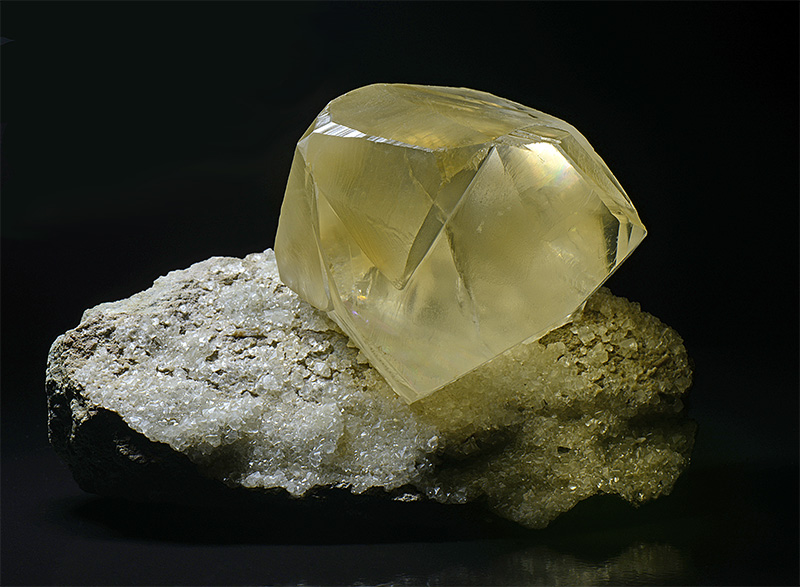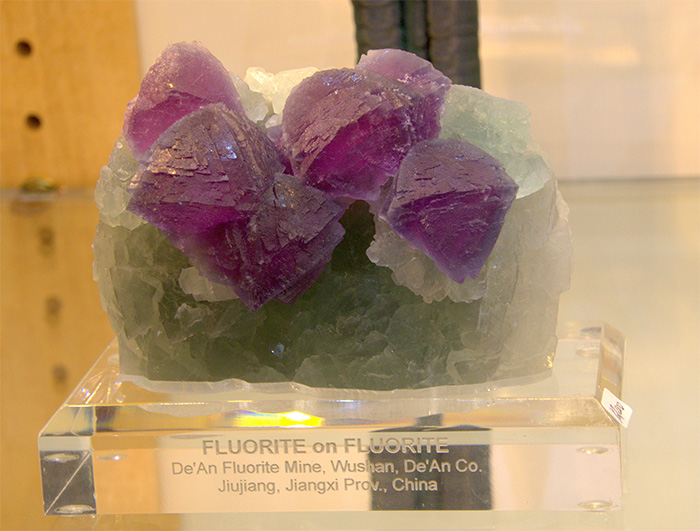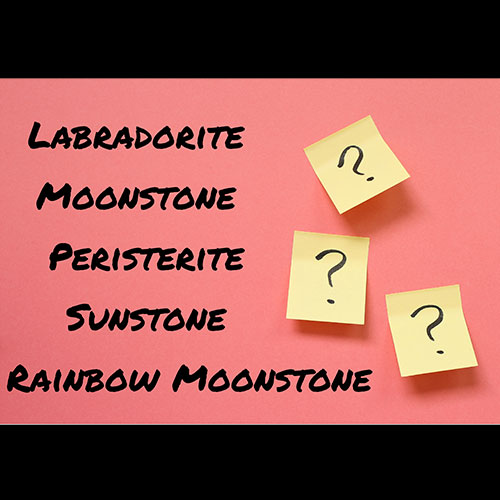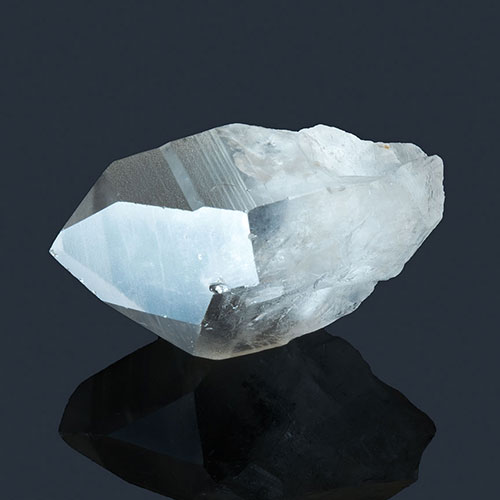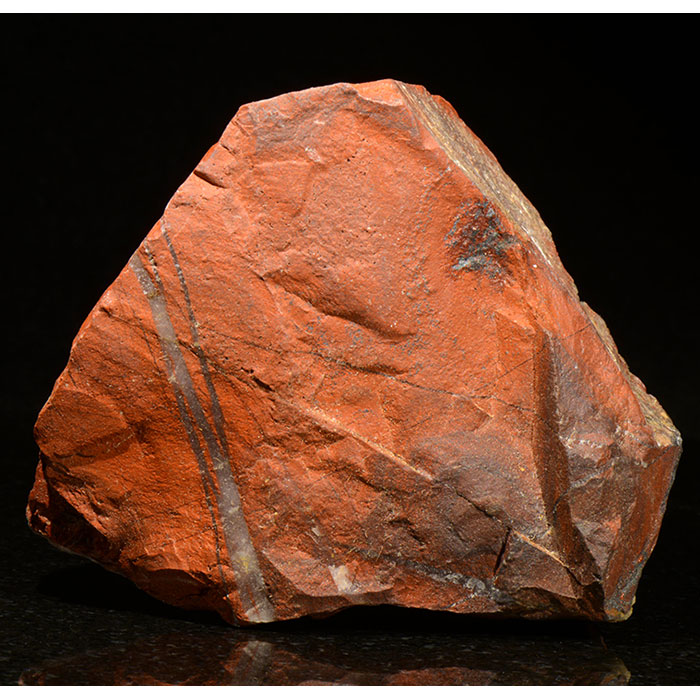Is a Crystal a Rock?

| Contents 1. Crystals are Not Rocks 2. What are Crystals? 3. What is a Mineral? 4. Crystals Made Up of Atoms 5. Is a Mineral a Rock? 6. What Makes a Rock? 7. The Word 'Crystals' 8. Article Pictures Reading time: 12–15 minutes |
Crystals are Not Rocks
The difference between crystals, rocks, and minerals causes so much confusion.
These three naturally occurring solids are not the same, so I hope this article will help you understand what makes each one different.
In this article, I'll answer the following questions:
- Are crystals rocks?
- What are minerals?
- What are rocks?
If you're looking for a quick answer, here it is:
Crystals are solids with an orderly, repeating internal structure. They're not rocks.
Minerals are naturally occurring solids with a crystalline structure.
Rocks are made from at least one mineral, but most are made from several.
For a more detailed explanation, read on.
So, What are Crystals?
The following two photos show crystals in the geological sense. The first mineral is quartz, the second is fluorite.
 Although crystals are the most obvious feature, these two pieces would usually be described as a mineral. A mineral is the material itself, regardless of whether it occurs as one crystal, many crystals, or has no visible crystals.
Although crystals are the most obvious feature, these two pieces would usually be described as a mineral. A mineral is the material itself, regardless of whether it occurs as one crystal, many crystals, or has no visible crystals.
The words ‘mineral’ and ‘crystal’ describe different aspects of the same material: a mineral is what it's made of: the chemical composition and internal atomic structure. Crystal is the shape it grows into when space allows, such as cubic, hexagonal, or prismatic.
So 'mineral' and 'crystal' are two ways of describing the same natural substance.
A mineral can appear in many forms. Quartz can form visible crystals, often as elongated hexagonal points. But it can also occur as a massive form, meaning its crystals are too small to see with the naked eye. Rose quartz is an example.
Quartz can also occur as tiny grains inside a rock.
However it appears, it is still the same mineral. Quartz is the mineral (the substance). A crystal is the shape the mineral has taken as it has grown.
In recent years, the use of the word 'crystals' by those who use rocks and minerals for their healing properties has added to the confusion, which I'll discuss later in this article.
What is a Mineral?
A mineral is an inorganic, naturally occurring solid with an internal crystalline structure. Inorganic means it does not come from or has been formed by living matter.
Quartz and fluorite are minerals, but pearls are not. Pearls are produced by marine oysters and freshwater mussels, which are organisms.
Wood is not a mineral because it's organic, but petrified wood is. That's because the organic matter in the original structure has been replaced with quartz, calcite, pyrite or occasionally opal. With the exception of opal, these materials are crystalline, so they're minerals.
Minerals form when molten rock (magma or lava) cools above or below Earth's surface. They can also form by separating from water rich in dissolved minerals.
The mineral halite forms when salt water evaporates. The dissolved minerals then crystallise to form cube-shaped crystals known as salt.
Some minerals can form in a few days, while others take millions of years. For a naturally occurring solid to be classed as a mineral, it must have an internal crystalline structure.
All crystals belong to one of seven crystal systems, but they can grow into many different external shapes depending on the space and conditions.
The mineral fluorite often exhibits cube-shaped crystals. Red Jasper is another mineral whose crystals are microscopic. These varieties are correctly known as microcrystalline or cryptocrystalline. Crystals described as macrocrystalline are large enough to be seen with the naked eye.

Crystals are Made Up of Atoms
A crystal is a highly ordered, repeating, three-dimensional arrangement of atoms.
It takes billions, trillions, and even quadrillions of atoms to form one single crystal. The way atoms come together is known as the crystal structure.
All crystals exhibit symmetry because they're made up of repeating geometric (regular lines and shapes) patterns.
The final form that a crystal takes is known as its habit. Cube-shaped crystals, also known as isometric, are among the most common and simplest shapes. Salt forms isometric crystals, while a snowflake is composed of hexagonal, six-sided crystals.
The following image is an example of a highly ordered repeating arrangement of atoms.

Crystals often, but not always, form when liquids cool and solidify. This process is called crystallisation. During crystallisation, atoms and molecules arrange themselves into a highly ordered, repeating pattern as the substance changes from a liquid to a solid. This organised arrangement leads to the formation of a crystalline solid.
Crystals are composed of repeating units of atoms arranged in a specific pattern, known as unit cells. A microscopic crystal can contain a small number of unit cells; a larger crystal can contain billions, trillions or more.
The arrangement of the unit cells forms a regular 3D structure called the crystal lattice. The shape of the unit cell and the symmetry of the lattice determine the external shape of the crystal's faces.
All states of matter, which include gases, liquids, and solids, are composed of atoms. For a solid to be crystalline, the atoms must be arranged in a highly ordered, repeating pattern. If this pattern is not present, the substance is non-crystalline.
In geology, amorphous means non-crystalline and describes the internal structure of a material, regardless of whether it's natural or man-made.
The word mineraloid is used to describe naturally occurring, non-crystalline solids. Obsidian and opal occur naturally, so they're mineraloids, but glass, which is man-made, is not, although it is amorphous.
Is a Mineral a Rock?
A mineral is not a rock because a rock is defined as a naturally occurring solid made up of one or more minerals. Most rocks contain several minerals, but some are composed of just one. These are called monomineralic rocks.
Examples of monomineralic rocks include marble (mostly calcite), quartzite (almost pure quartz), and certain types of limestone which are made up almost entirely of calcite.
There are approximately five thousand minerals on Earth, yet the vast majority of rocks are formed from a combination of some of the most common.
Known as rock-forming minerals, they include feldspars, quartz, amphibole, micas, olivine, garnet, calcite and pyroxenes.
Minerals often contain traces of other minerals or substances. These impurities can bring about a change in colour. The purple colour of amethyst is primarily due to trace amounts of iron.
An impurity is not the same as an inclusion.
What Makes Something a Rock?
Rocks are a combination of different minerals that come together through various geological processes. The minerals present and the way they’re arranged (texture) determine the type of rock that forms.
In rocks, 'texture' means how the minerals are arranged and their size. It doesn't mean how the rock feels to the touch.
To determine whether something is a rock, the following must be considered:
- What minerals it contains
- How they're arranged
- Are the mineral crystals small or large?
- Are they all the same size or mixed?
- Are the grains rounded or sharp?
- Are the layers visible?
- Are the minerals interlocking?
Unlike minerals, some rocks can be organic, meaning they're made of materials that were once part of a living organism. Only sedimentary rocks can be organic. An example is coal, which formed over millions of years from compressed plants.
Some types of limestone are organic.
Sedimentary rocks often contain shells and skeletons of marine organisms whose remains accumulate as sediment. Over time, the sediment becomes buried, compaction squeezes out any water, and cementation gradually binds layers together. The hardened mass then slowly transforms into sedimentary rock.
The three main rock types are sedimentary, igneous, and metamorphic. Sedimentary rocks form from sediments and particles, which can be organic or inorganic.
Igneous rocks form from molten rock that cools and solidifies above or below Earth's surface. Magma is a molten mixture of chemical elements that will eventually crystallise into minerals as it cools. It remains fluid because of immense heat and pressure.
Rocks that formed as magma cooled and solidified beneath the Earth's surface are known as intrusive igneous rocks. Those formed from lava on Earth's surface are extrusive rocks.
The size of crystals that form is determined by the length of time that it takes for the magma or lava to cool and solidify. Where this happens over thousands to millions of years, crystals have plenty of time to grow, so will be very large.
When lava cools and solidifies rapidly, there is less time for crystal growth. Therefore, crystals will either be very small or nonexistent.
This rapid cooling results in a naturally occurring solid that lacks a crystalline structure. This material often produces volcanic glass, which is a mineraloid.
Obsidian is one type of volcanic glass, but there are many. The specific type that forms depends on factors including the composition of the lava or magma and the cooling conditions.
Opal, known for its play of colour, and also shungite, are non-crystalline but are not volcanic glass.
When magma or lava cools and solidifies, the minerals in the molten rock crystallise. A mineral only begins to form when atoms organise themselves into a highly ordered, repeating pattern, creating the crystal structure.
Rocks are not generally described as crystalline, even though they're composed of crystalline minerals. The term ‘crystalline’ is used to describe minerals, not rocks as a whole.
I haven't spoken about metamorphic rocks, but discuss them here.
The Word 'Crystals'
In recent years, the word 'crystals' has become a generic term for rocks and minerals used for their metaphysical healing properties. It's not used by geologists or those whose interest in these materials is scientific.
The word was popularised by the New Age movement of the 1970s and 80s and is now widely used in what has become a multi-billion-dollar industry.
In many cases, the word is a misnomer and, from a geological perspective, often incorrect. When used in a metaphysical context, it's not meant literally, but its widespread use has created confusion.
The word 'crystals' refers to many different materials, most of which are visually attractive. They may or may not be crystalline in the true geological sense, and some, such as goldstone and opalite are man-made. While the rarity of rocks and minerals can vary widely, crystals in the true sense of the word are extremely common. Some of the most common crystalline substances include ice, which is crystallised water, sugar, which is crystallised sucrose, and sand, which is crystals of silicon dioxide.
While the rarity of rocks and minerals can vary widely, crystals in the true sense of the word are extremely common. Some of the most common crystalline substances include ice, which is crystallised water, sugar, which is crystallised sucrose, and sand, which is crystals of silicon dioxide.![]() (*)
(*)
Many people are surprised to learn that lead crystal is not crystalline. Despite the name, it's a type of glass that contains lead.
Article Pictures
Quartz crystals var. amethyst, fluorite, halite - Courtesy of Stan Celestian.
Red Jasper - Courtesy of James St.John.
Photos are clickable and redirect to the original image.
"How to Identify Rocks" courtesy of Bill Langer, U.S Geological Survey.
Pop-up photos: Quartz, amphibole (on calcite) - Courtesy of Ron Wolf. Fluorite - Courtesy of Steve Blyskal.
Calcite, pyrite, opal, marble, limestone, olivine - Courtesy of Stan Celestian.
The remaining pieces in the pop-up photos come from our collection.






